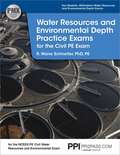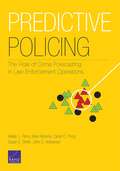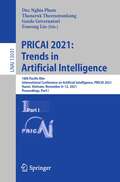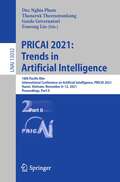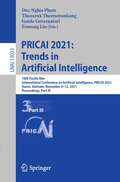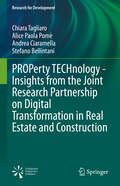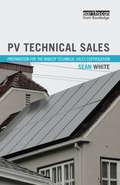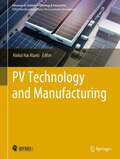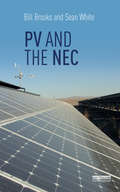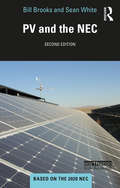- Table View
- List View
PPI Thermal and Fluids Systems Six-Minute Problems eText - 1 Year
by Daniel C. Deckler PhD, PEProblems and Detailed Solutions for Comprehensive Exam Prep Please note: As of October 25, 2019, the NCEES PE Mechanical Exam is NO LONGER open book. Up to date to the NCEES exam specifications and codes*, Thermal and Fluids Systems 6-Minute Problems contains 100 multiple-choice problems representative of the NCEES PE Mechanical Thermal and Fluids Systems exam format, scope of topics, and level of difficulty. Comprehensive step-by-step solutions for all problems demonstrate accurate and efficient solving approaches to be used on exam day. Pair these problems with the Thermal & Fluids Systems Reference Manual and Practice Exams for a comprehensive review. This book is included in the PE Mechanical Thermal and Fluids Systems Exam Navigation Bundle.Topics CoveredEnergy/Power System ApplicationsHydraulic and Fluid ApplicationsPrinciplesAbout the Exam The NCEES PE Mechanical Exam is an 8-hour closed-book exam. It contains 40 multiple choice questions in the 4-hour morning session and 40 multiple choice questions in the 4-hour afternoon session. *NCEES does not specify which codes and standards the PE Mechanical Thermal and Fluids Systems exam will use. It is likely that the codes and standards needed are not affected by the differences from one edition to the next.Key Features:Organized into three sections: Principles, Hydraulic and Fluid applications, and Energy/Power System Applications.Each section contains problems pertaining to the knowledge areas within that division of the NCEES specifications. Each problem statement in this book, with its supporting information and answer choices, is presented in the same format as the problems encountered on the PE exam. Each problem includes a hint to provide direction in solving the problem. In addition to the correct solution, you will find an explanation of the faulty reasoning leading to the three incorrect answer choices. Binding: PaperbackPublisher: PPI, A Kaplan Company
PPI Transportation Depth Practice Exams for the PE Civil Exam, 2nd Edition eText - 1 Year
by Dale R. Gerbetz PERealistic Practice for the NCEES PE Civil Transportation ExamTransportation Depth Practice Exams for the PE Civil Exam contains two multiple-choice exams consistent with the NCEES PE Civil Transportation Exam&’s format and specifications. Like the actual exam, the problems require an average of six minutes to solve and can be taken within the same four home time limit as the actual exam to enhance time-management skills. Comprehensive step-by-step solutions demonstrate accurate and efficient problem-solving approaches. Solutions also frequently refer to the codes and references adopted by NCEES to help you determine which resources you'll likely use on exam day.Topics Covered (Capacity Analysis and Transportation Planning)Alternatives AnalysisDrainageGeotechnical and PavementHorizontal DesignIntersection GeometryRoadside and Cross-Section DesignSignal DesignTraffic Control DesignTraffic EngineeringVertical DesignKey FeaturesConsistent with the exam scope and formatLearn accurate and efficient problem-solving approachesConnect relevant theory to exam-like problemsIndividual answer keys with step-by-step solutionsExam-adopted codes and standardsBinding: PaperbackPublisher: PPI, A Kaplan Company
PPI Transportation Depth Reference Manual for the Civil PE Exam eText - 1 Year
by Norman Voigt PE, PLSComprehensive Coverage of the PE Civil Exam Transportation Depth Section The Transportation Depth Reference Manual for the PE Civil Exam prepares you for the transportation depth section of the NCEES PE Civil Transportation Exam. It provides a concise, yet thorough review of the transportation depth section exam topics and associated equations. More than 25 end-of chapter problems and 45 example problems, all with step-by-step solutions, show how to apply concepts and solve exam-like problems. A thorough index directs you to more than 280 equations, 150 tables, 140 figures, 35 appendices, and to the exam-adopted codes and standards.Topics Covered Geometric DesignPedestrian and Mass Transit Analysis Traffic and Capacity Analysis Traffic SafetyTransportation ConstructionTransportation Planning Referenced Codes and StandardsAASHTO Green Book, 6th Edition (2011) AASHTO Guide for Design of Pavement Structures (1993, and 1998 supplement) AASHTO Guide for the Planning, Design, and Operation of Pedestrian Facilities, 1st Edition (2004) AASHTO Highway Safety Manual, 1st Edition (2010) AASHTO Mechanistic-Empirical Pavement Design Guide: A Manual of Practice, 2nd Edition (2015) AASHTO Roadside Design Guide, 4th Edition (2011)AI The Asphalt Handbook, 7th Edition (2007)FHWA Hydraulic Design of Highway Culverts, 3rd Edition (2012)HCM Highway Capacity Manual, 6th Edition (2016) MUTCD Manual on Uniform Traffic Control Devices (2009, including revisions in 2012)PCA Design and Control of Concrete Mixtures, 16th Edition (2016)PROWAG Proposed Accessibility Guidelines for Pedestrian Facilities in the Public Right-of-Way (2011, and 2013 supplement)Key FeaturesA robust index to facilitate quick referencing during the PE Civil Exam.Highlights the most useful equations in the exam-adopted codes and standards.Binding: PaperbackPublisher: PPI, A Kaplan Company
PPI Transportation Depth Six-Minute Problems for the PE Civil Exam eText - 1 Year
by Norman Voigt PE, PLSTargeted Training for Solving PE Civil Transportation Depth Exam Multiple-Choice ProblemsTransportation Depth Six-Minute Problems for the PE Civil Exam contains 91 multiple-choice problems that are grouped into 10 chapters that correspond to a topic on the PE Civil exam transportation depth section. Problems are representative of the exam&’s format, scope of topics, and level of difficulty. Like the PE exam, an average of six minutes is required to solve each problem in this book. Each problem also includes a hint for optional problem-solving guidance. Comprehensive step-by-step solutions for all problems demonstrate accurate and efficient solving approaches.Topics CoveredAlternatives Analysis Drainage Geotechnical and Pavement Horizontal Design Intersection Geometry Roadside and Cross-Section DesignSignal DesignTraffic Control DesignTraffic EngineeringVertical DesignKey FeaturesIncrease familiarity with the exam problems&’ format, content, and solution methods Connect relevant theory to exam-like problemsQuickly identify accurate problem-solving approachesOrganize the references you will use on exam dayBinding: PaperbackPublisher: PPI, A Kaplan Company
PPI Water Resources and Environmental Depth Practice Exams for the Civil PE Exam eText - 1 Year
by R. Wane Schneiter PhD, PERealistic Practice for the PE Civil Water Resources and Environmental ExamWater Resources and Environmental Depth Practice Exams includes two 40-problem exams consistent with the NCEES Civil PE water resources and environmental depth exam&’s scope of topics, level of difficulty, and multiple-choice format. Taking each exam in a simulated exam setting will help you prepare for solving problems under timed conditions and identify which references you'll need on exam day. Consistent with the actual Civil PE exam, an average of six minutes is required to solve each problem in this book. Comprehensive step-by-step solutions illustrate accurate and efficient solution approaches. Author commentary is provided in the solutions, explaining time-saving shortcuts and common pitfalls. You&’ll be able to quickly evaluate your performance using the included answer keys and identify areas for further review.Key FeaturesConsistent with the exam scope and formatLearn accurate and efficient problem-solving approachesConnect relevant theory to exam-like problemsSolve problems in an exam-like timed settingBinding: PaperbackPublisher: PPI, A Kaplan Company
PPI Water Resources and Environmental Depth Reference Manual for the Civil PE Exam eText - 1 Year
by Jonathan Brant PhD Gerald J. Kauffman PhD, PEThe Water Resources and Environmental Depth Reference Manual for the Civil PE Exam prepares you for the water resources and environmental depth section of the NCEES PE Civil Water Resources and Environmental Exam. It provides a complete introduction to the water resources and environmental depth section of the Civil PE exam with clear, easy-to-understand explanations of water resources and environmental engineering concepts. The comprehensive reference manual includes example problems that demonstrate how concepts are applied, and end-of-chapter problems for independent practice. Plus, the detailed tables, figures, and appendices are a great resource for solving the example problems. Topics coveredActivated SludgeEnvironmental RemediationGroundwater EngineeringHazardous Waste and PollutantsHydraulics—Closed ConduitHydraulics—Open ChannelHydrologyWaste and Wastewater Composition and ChemistryWastewaterWastewater TreatmentWater Treatment Key featuresAn overview of the Ten States Standards.115 solved example problems.101 exam-like, end-of-chapter problems with complete solutions.230 equations, 65 tables, 102 figures, and 8 appendices.An easy-to-use index.Binding: PaperbackPublisher: PPI, A Kaplan Company
PREDICTIVE POLICING: The Role of Crime Forecasting in Law Enforcement Operations
by Walter L. Perry Brian Mcinnis Carter C. Price Susan C. Smith John S. HollywoodPredictive policing is the use of analytical techniques to identify targets for police intervention with the goal of preventing crime, solving past crimes, or identifying potential offenders and victims. These tools are not a substitute for integrated approaches to policing, nor are they a crystal ball. This guide assesses some of the most promising technical tools and tactical approaches for acting on predictions in an effective way.
PRICAI 2021: 18th Pacific Rim International Conference on Artificial Intelligence, PRICAI 2021, Hanoi, Vietnam, November 8–12, 2021, Proceedings, Part I (Lecture Notes in Computer Science #13031)
by Fenrong Liu Guido Governatori Thanaruk Theeramunkong Duc Nghia PhamThis three-volume set, LNAI 13031, LNAI 13032, and LNAI 13033 constitutes the thoroughly refereed proceedings of the 18th Pacific Rim Conference on Artificial Intelligence, PRICAI 2021, held in Hanoi, Vietnam, in November 2021.The 93 full papers and 28 short papers presented in these volumes were carefully reviewed and selected from 382 submissions. PRICAI covers a wide range of topics in the areas of social and economic importance for countries in the Pacific Rim: artificial intelligence, machine learning, natural language processing, knowledge representation and reasoning, planning and scheduling, computer vision, distributed artificial intelligence, search methodologies, etc. Part I includes the following topical headings: AI Foundations / Decision Theory, Applications of AI, Data Mining and Knowledge Discovery, Evolutionary Computation / Optimisation, Knowledge Representation and Reasoning.
PRICAI 2021: 18th Pacific Rim International Conference on Artificial Intelligence, PRICAI 2021, Hanoi, Vietnam, November 8–12, 2021, Proceedings, Part II (Lecture Notes in Computer Science #13032)
by Fenrong Liu Guido Governatori Thanaruk Theeramunkong Duc Nghia PhamThis three-volume set, LNAI 13031, LNAI 13032, and LNAI 13033 constitutes the thoroughly refereed proceedings of the 18th Pacific Rim Conference on Artificial Intelligence, PRICAI 2021, held in Hanoi, Vietnam, in November 2021.The 93 full papers and 28 short papers presented in these volumes were carefully reviewed and selected from 382 submissions. PRICAI covers a wide range of topics in the areas of social and economic importance for countries in the Pacific Rim: artificial intelligence, machine learning, natural language processing, knowledge representation and reasoning, planning and scheduling, computer vision, distributed artificial intelligence, search methodologies, etc. Part II includes two thematic blocks: Natural Language Processing, followed by Neural Networks and Deep Learning.
PRICAI 2021: 18th Pacific Rim International Conference on Artificial Intelligence, PRICAI 2021, Hanoi, Vietnam, November 8–12, 2021, Proceedings, Part III (Lecture Notes in Computer Science #13033)
by Fenrong Liu Guido Governatori Thanaruk Theeramunkong Duc Nghia PhamThis three-volume set, LNAI 13031, LNAI 13032, and LNAI 13033 constitutes the thoroughly refereed proceedings of the 18th Pacific Rim Conference on Artificial Intelligence, PRICAI 2021, held in Hanoi, Vietnam, in November 2021.The 93 full papers and 28 short papers presented in these volumes were carefully reviewed and selected from 382 submissions. PRICAI covers a wide range of topics in the areas of social and economic importance for countries in the Pacific Rim: artificial intelligence, machine learning, natural language processing, knowledge representation and reasoning, planning and scheduling, computer vision, distributed artificial intelligence, search methodologies, etc. Part III includes two thematic blocks: Reinforcement Learning, followed by Vision and Perception.
PRIMA 2020: 23rd International Conference, Nagoya, Japan, November 18–20, 2020, Proceedings (Lecture Notes in Computer Science #12568)
by Quan Bai Takahiro Uchiya Iván Marsá MaestreThis book constitutes the refereed proceedings of the 23rd International Conference on Principles and Practice of Multi-Agent Systems, PRIMA 2020, held in Nagoya, Japan, in November 2020. The 19 full papers presented and 13 short papers were carefully reviewed and selected from 50 submissions.Due to COVID-19, the conference was held online. The conference covers a wide range of ranging from foundations of agent theory and engineering aspects of agent systems, to emerging interdisciplinary areas of agent-based research.
PRIMA 2024: 25th International Conference, Kyoto, Japan, November 18–24, 2024, Proceedings (Lecture Notes in Computer Science #15395)
by Takayuki Ito Sebastian Stein Reyhan Aydoğan Victor Sanchez-Anguix Leon van der Torre Ryuta ArisakaThis book constitutes the refereed proceedings of the 25th International Conference on Principles and Practice of Multi-Agent Systems, PRIMA 2024, held in Kyoto, Japan, during November 18–24, 2024. The 23 full papers and 10 short papers presented in this volume were carefully reviewed and selected from 76 submissions. They are organized in the following topical sections: coordination and cooperation; market approaches; logics; learning; agent-based modelling and simulation; computational social choice.
PRIVATE LIVES
by Karen YoungElizabeth Walker has spent most of the past three decades trying to forget the loss of her mother and father, a lonely childhood spent in a series of foster homes and the two baby sisters she hasn't seen in twenty-five years. She values her privacy above everything, and has built a wall around herself that few people have ever climbed.But when her best friend, Gina, risks losing her young daughter to an impersonal court system-the same system that failed Elizabeth many years ago-she vows to fight back. But Elizabeth needs help. She needs the kind of help that a family can give, and she needs Ryan Paxton, the brilliant attorney whose tragic family history is intertwined with her own.As the custody battle turns to something more dangerous-and more deadly-Elizabeth comes face-to-face with a past she has tried to forget and a future she wants to embrace.
PROFESSIONAL SOCIETIES and Ecologically Based Pest Management: Proceedings of a Workshop
by Board On Agriculture Natural ResourcesThe National Academies Press (NAP)--publisher for the National Academies--publishes more than 200 books a year offering the most authoritative views, definitive information, and groundbreaking recommendations on a wide range of topics in science, engineering, and health. Our books are unique in that they are authored by the nation's leading experts in every scientific field.
PROMOTING INNOVATION: 2002 Assessment of the Partnership for Advancing Technology in Housing
by Committee for Review Assessment of the Partnership for Advancing Technology in HousingAn Assessment of the Partnership for Advancing Technology in Housing
PROPerty TECHnology - Insights from the Joint Research Partnership on Digital Transformation in Real Estate and Construction (Research for Development)
by Andrea Ciaramella Chiara Tagliaro Alice Paola Pomè Stefano BellintaniThe book presents insights from over five years of research by the Real Estate Center at the Department of Architecture, Built environment and Construction engineering (ABC) of Politecnico di Milano, within the Italian PropTech Network initiative. It explores how digital technology is addressing key challenges in the built environment, such as climate change, urbanization, rising costs, and demographic shifts. Traditionally slow to adapt, the real estate sector must embrace innovation to meet urgent Sustainable Development Goals. Focusing on digitalization, the book analyzes tools and technologies that can transform property management, enhance market processes, and add value for stakeholders. It provides a broad literature review, defines PropTech, and examines its role in reshaping the construction and real estate industry. Case studies illustrate the sector&’s ongoing transformation while critically evaluating different PropTech applications. The book contributes to academic debate and supports real estate professionals navigating digital transformation by systematizing current knowledge. It also highlights potential risks, emphasizing the need for further research to ensure sustainable and informed innovation.
PSPICE and MATLAB for Electronics: An Integrated Approach, Second Edition (VLSI Circuits)
by John Okyere AttiaUsed collectively, PSPICE and MATLAB are unsurpassed for circuit modeling and data analysis. PSPICE can perform DC, AC, transient, Fourier, temperature, and Monte Carlo analysis of electronic circuits with device models and subsystem subcircuits. MATLAB can then carry out calculations of device parameters, curve fitting, numerical integration, nume
PV Technical Sales: Preparation for the NABCEP Technical Sales Certification
by Sean WhiteNABCEP sets the standard for solar certifications in the United States and Canada. The NABCEP PV Technical Sales Certification shows customers, friends and employers that you are knowledgeable and qualified to sell solar systems. If someone is selling solar, they need to know what they are selling and how it is configured. Where will they connect the circuit breaker? Will the house need expensive modifications in order for a PV system to be installed? These are the questions that you as a NABCEP Technical Sales Certified solar salesperson will confidently answer. This book is full of practical information that anyone selling solar should know in order to properly serve their customers and to ethically represent the industry that is solving the world’s problems on the ground and rooftop level. This book will be of use to those taking the NABCEP PV Technical Sales Exam, as well as anyone selling or planning to sell solar.
PV Technology and Manufacturing (Advances in Science, Technology & Innovation)
by Abdul Hai AlamiThis book discusses the manufacturing processes of photovoltaic solar cells, from conventional silicon cells, to thin-film technologies and ending with the cutting-edge technologies of third-generation photovoltaics. The rapid advances in photovoltaic technologies are propelled by the discovery of new materials through innovative routes of synthesis and deposition. For example, the exponential enhancement in efficiencies of perovskite solar cells between years 2015 and 2020 is a direct result of the availability of new materials to capitalize on innovative manufacturing techniques. Currently, efficiencies of up to 25.5% are achieved by perovskite solar cells technologies. This book is intended for scientists and engineers who are keen on having a solid understanding of conventional manufacturing processes of bulk silicon for photovoltaic purposes, as well as advanced processes used to synthesize materials for emerging photovoltaic technologies such as thin-film and third-generation PV. The book is designed to be self-contained to allow the reader to develop knowledge and experience in materials selection as well as a good understanding of pertinent manufacturing process to arrive at best device performance. The technologies presented are also analyzed for its energy and environmental impacts.
PV and the NEC
by Bill Brooks Sean WhiteUsed throughout the United States and many other countries, the National Electric Code (NEC) is the world’s most detailed set of electrical codes pertaining to photovoltaic (PV) systems. Photovoltaic Systems and the National Electric Code presents a straightforward explanation of the NEC in everyday language. The new book is based on the 2017 NEC, which will be used widely until 2023, with most of the interpretations and material staying true long after. This book interprets the distinct differences between previous versions of the NEC and the 2017 NEC and clarifies how these Code changes relate specifically to photovoltaic installations. Written by two of the leading authorities and educators in the field, this book will be a vital resource for solar professionals, as well as anyone preparing for a solar certification exam.
PV and the NEC
by Bill Brooks Sean WhiteUsed throughout the United States and many other countries, the National Electrical Code (NEC) is the world’s most detailed set of electrical codes pertaining to photovoltaic (PV) systems. PV and the NEC presents a straightforward explanation of the NEC in everyday language. This new edition is based on the 2020 NEC, which will be used widely until 2026, with most of the interpretations and material staying true long after. This book interprets the distinct differences between previous versions of the NEC and the 2020 NEC and clarifies how these code changes relate specifically to PV installations. Written by two of the leading authorities and educators in the field, this book will be a vital resource for solar professionals, as well as anyone preparing for a solar certification exam.
PV and the NEC
by Bill Brooks Sean WhitePV and the NEC presents a straightforward explanation of the National Electrical Code (NEC) in everyday language. Used throughout the United States and many other countries, the NEC is the world’s most detailed set of electrical codes pertaining to photovoltaic (PV) systems. This new edition is based on the 2023 NEC, with most of the interpretations and material staying true long after. It interprets the distinct differences between previous versions of the NEC and the 2023 NEC and clarifies how these code changes relate specifically to PV installations. It includes Energy Storage Systems (ESS) and EV to Grid (EV2G). Written by two of the leading authorities and educators in the field, this book will be a vital resource for solar professionals, as well as anyone preparing for a solar certification exam.
PVC: Production, Properties and Uses
by G. MathewsA study on the production, properties and uses, of PVC, Polyvinyl chloride which is the world's third-most widely produced synthetic plastic polymer by the Institute of Materials, London in 1996
Pacific Automobilism: Adventure, Status and the Carnival of Mobility, 1970–2015
by Gijs MomThe beginning of the 21st century has seen important shifts in mobility cultures around the world, as the West’s media-driven car culture has contrasted with existing local mobilities, from rickshaws in India and minibuses in Africa to cycling in China. In this expansive volume, historian Gijs Mom explores how contemporary mobility has been impacted by social, political, and economic forces on a global scale, as in light of local mobility cultures, the car as an ‘adventure machine’ seems to lose cultural influence in favor of the car’s status character.
Pacific Coast Highway in California (Images of America)
by Carina Monica MontoyaMore commonly known as Pacific Coast Highway, State Route 1 ribbons along or near the Pacific Ocean from Northern California at Leggett in Mendocino down to Southern California at San Juan Capistrano in Orange County. Its construction began in 1913 and was done incrementally, largely because of funding issues, shortage of labor, legal challenges, deep canyons, steep mountains, solid rock, and unstable earth. A true modern marvel, its unique and extraordinary construction allows easy access to some of the country's most famous and historical places and picturesque sights. Thousands of pounds of dynamite were used to blast through granite, marble, and sandstone to build a highway following near or along the coastline. Among the 33 bridges along the route is the remarkable Bixby (Rainbow) Bridge at Big Sur. The highway wends its way through some of the most magnificent and scenic landscapes and historical places found between Ventura and Humboldt Counties, making it more than just a road. It is a destination.




